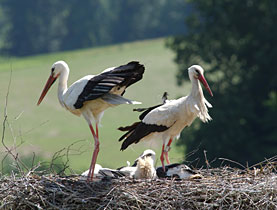Museum mourns migrating Max

Max the stork, the grand old lady of Swiss bird research, has been found dead in Spain at the age of 13 and a half. No other animal in the world has been tracked by satellite over such a long period, experts say.
The museum of natural history in Fribourg, which had tracked her since she was two months old, said in a press statement on Thursday that by the time the body was found it had been half eaten, making it impossible to determine the exact cause of death.
However, since it was close to a power line, it is possible that she was electrocuted.
The museum suspected something was wrong when the tracking device showed no movement over several days.
Spanish ornithologists then went to the spot and found the corpse and the tracking device which was still working.
Storks numbers fell drastically in Switzerland in the first half of the 20th century, and they were extinct by 1950.
Max Bloesch, after whom Max was named, campaigned to reverse this. He organised the colony at Altreu near Solothurn, which he initially people with birds from Alsace in France and the then Czechoslovakia. Later he brought large numbers of young storks from Algeria.
By the time he died in 1997, there were 170 breeding pairs in Switzerland as a whole.
According to Fasel, there are now about 280 breeding pairs, and up to 700 individuals.
Storks like to nest in groups; there are colonies in Altreu near Solothurn, Avenches in canton Vaud, in the Jura, and in the Zurich region.
It is not possible to know where storks will choose to lay their eggs: they almost always look for somewhere other than where they were born.
This is one reason why Max was tracked.
More and more people are encouraging storks to nest, by placing such things as cart wheels on roofs.
Unusual bird
Max proved an exceptional bird over her long life.
The tracking device was originally fitted as an experiment when Max was about two months old, museum director André Fasel told swissinfo.ch. “Since the results were satisfactory, the following year we fitted 25 more. For whatever reason, none of the 25 we fitted in 2000 transmitted any information at all.”
No-one knows how Max managed to achieve such longevity; only one in five storks in Switzerland even reaches sexual maturity.
Max was born in May 1999 in Avenches, in western Switzerland. She spent her first eight winters in Morocco, and since then overwintered in Spain, either in Andalusia in the south, or near Madrid.
Over the course of her lifetime she produced 31 chicks – a success rate of 2.8 per year, far above the Swiss average of 1.7.
She bred for the first time in 2002 north of Lake Constance in Germany. It was only then that ornithologists realised that she was a female. She had been named after Max Bloesch who brought storks back to Switzerland after they had died out in 1950.
She provided ornithologists with a mass of interesting information about the migration of white storks. Each year they learned when she started migration, her route, the length of time spent migrating and the speed achieved, when she arrived and when she started back, and whether she changed strategy from one year to the next.
Max usually flew between 100 and 300 kilometres a day when migrating. With favourable winds this could reach 400, and very occasionally more than 500. Over her lifetime she flew more than 60,000.
Although Max nested just over the border in Germany, she was no stranger to Switzerland. She always flew over Switzerland to migrate. Last autumn she spent nearly a week, on a route that took her via Zurich and Baden, stopping at Altreu, a famous stork colony near Solothurn, and near Yverdon, in the west, Fasel said.
She was very well known in Switzerland. About 6,000 people subscribed to the museum’s newsletter in order to follow her progress, said Fasel. Children’s author Katja Alves published an “autobiography” about her to mark her tenth birthday.
But Max was a one-off for the museum.
None of her descendants have been monitored, and no storks are now being tracked by satellite. Instead, the museum is currently following six red kites.
“I won’t say we know everything there is to know about storks, but there are so many other subjects that deserve attention, other species about which we know very little, that we won’t be doing a Max remake,” Fasel explained.

In compliance with the JTI standards
More: SWI swissinfo.ch certified by the Journalism Trust Initiative










You can find an overview of ongoing debates with our journalists here . Please join us!
If you want to start a conversation about a topic raised in this article or want to report factual errors, email us at english@swissinfo.ch.